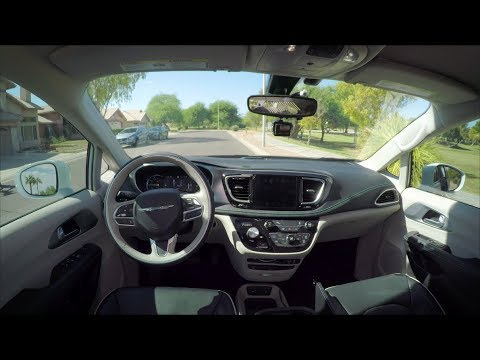Autonomous Vehicles
Waymo’s Plan to Take You into the Self-Driving World of Tomorrow
Google spinout Waymo has been a major player in the world of self-driving cars since its inception, and now the technology is nearing market readiness, the company has serious plans to dominate. Lucy Ingham hears from CEO John Krafcik about the plans to make driverless cars a key part of our everyday lives
Recently, an announcement was made that may go on to be remembered as one of the key moments in the development of self-driving cars. After years of work, Google spinout Waymo announced that it had become the first driverless car company to test-drive its vehicles on public roads without anyone behind the wheel.

John Krafcik, CEO of Waymo
“This wasn't just a one-time ride or just a demo: what you're seeing now marks the start of a new phase for Waymo, and for the history of this technology,” says Waymo CEO John Krafcik, in a talk at Web Summit where he made the announcement.
“We're test-driving these fully self-driving vehicles in a part of the Phoenix metro area in Arizona. Over time we'll expand to cover the entire Phoenix region, an area much larger than Greater London. And our ultimate goal is to bring our fully self-driving technology to more cities in the US and around the world. Fully self-driving cars are here.”
For Waymo, this removal of a person in the driving seat – even merely as a safety precaution – is a key achievement, representing the culmination of years of work.
But while technology has undoubtedly been the focus, Waymo has also paid close attention to the experience of being in the vehicle, recognising that if it is to achieve the mass adoption it hopes for, it needs to fine-tune every detail to make giving up driving something users feel happy to do.
And with its efforts now turning to making its cars a core part of the fabric of the future, it’s clear Waymo is ramping up focus on convincing consumers and businesses to not take the wheel.
Inside Waymo’s truly self-driving car
Waymo’s fleet consists of Fiat Chrysler minivans, Chrysler Pacifics, which the company selected for their image as a trusted family car. However, in its extensive adaptations to the car giant’s original model, it has produced a vehicle that is tuned to work safely in almost any environment.
“It's a plugin hybrid minivan with power sliding doors and a top safety rating,” says Krafcik proudly. “We outfitted our cars an array of hardware, including a powerful AI computer platform, along with lasers, camera and radar. We developed these entirely in-house and this is the most advanced vehicle that we developed to-date. Everything in it – everything – is designed and built for full autonomy.”
This level of safety is largely a result of the number of ‘eyes’ the car has, allowing it to sense the world around it at a level unmatched even by human drivers.
“Our combination of powerful sensors gives our vehicles a 360-degree view of the world. The lasers can see objects in three dimensions, up to 300m away,” he says. “We also have short-range lasers that stay focused on things close to the car, and our radars can see underneath and around vehicles, even tracking moving objects hidden from the human eye.
“We have high-resolution vision systems that allow our vehicles to see in a wide variety of lighting conditions, ranging from an unlit parking lot in the middle of the night, to the blazing sun at sunset. And with our hardware engineers working side-by-side with our software team and our AI experts at Waymo, we're able to design everything to work together seamlessly.”
“Our system runs thousands of checks on itself every second. With these checks, our systems can instantly diagnose any problem, and pull over to a safe stop if needed”
It’s clear Waymo wants to ensure its vehicles have a pristine record, far surpassing human drivers, likely taking the view that wary consumers will accept nothing less if they are to trust the technology.
Inside the car’s onboard computers, this safety theme continues, with an almost over-careful level of support.
“Our system runs thousands of checks on itself every second. With these checks, our systems can instantly diagnose any problem, and pull over to a safe stop if needed,” explains Krafcik. “But for more critical driving functions, we go a step beyond that, and add in secondary systems: today all of our minivans have backups for steering, for breaking, computing and power.”
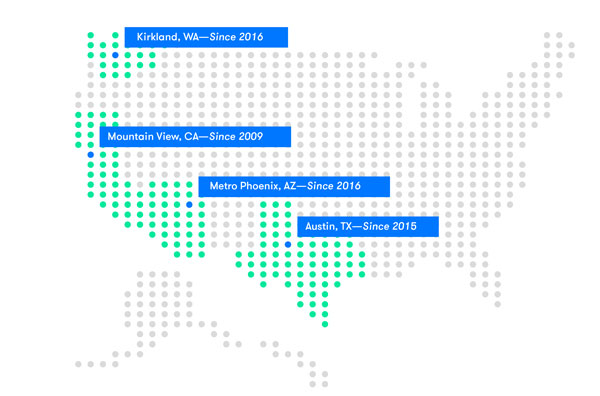
Current US testing locations for Waymo’s self-driving vehicles
Taking driverless car testing to extremes
Of course, to have this level of confidence Waymo has had to take its vehicles through an incredible amount of testing since the company’s early days, in what Krafcik describes as “the world's longest, toughest ongoing driving test”.
“In the last eight years, Waymo's vehicles have driven more than five and a half million autonomous kilometers on public roads, and that's across more than 20 cities. That's about 120 times around the globe,” he says.
“We also practice rare and unusual situations we might encounter on our private test track, a mock city, really, complete with traffic lights, railway crossings, roundabouts and high-speed roads. We've created more than 20,000 scenarios there for our vehicles to practice, and that includes everything from blowing stacks of paper at our vehicle's sensors to having people jump out of a box in surprise at our cars.”
While this may seem absurd, in such a carefully planned rollout these nuggets seem chosen to stick in people’s minds and present a light-hearted image of self-driving that is friendly and trustworthy. Who could fear a technology that stops even when someone leaps out of a box at it?
“We've created more than 20,000 scenarios there for our vehicles to practice, and that includes everything from blowing stacks of paper at our vehicle's sensors to having people jump out of a box in surprise at our cars”
But away from roadside buffoonery, the company is also keen to highlight the technological sophistication that underpins its offering.
“We built a virtual world where our vehicles can re-drive and practice every mile we've ever driven. In our simulator, we have the equivalent of 25,000 vehicles driving these virtual streets every hour of every day, focused on the most complex and challenging parts of driving,” Krafcik explains.
“In the last 12 months alone, we've completed over 4 billion kilometres of virtual driving, and we continue to pick up experience at a rapid pace: right now we're driving about 16,000km every day on public roads, and driving another 16 million kilometres each day in simulation. That's a lot of driving.
“We go through all these efforts because we know that experience is absolutely the best teacher, and we're out to make Waymo the most experienced driver on the road today.”
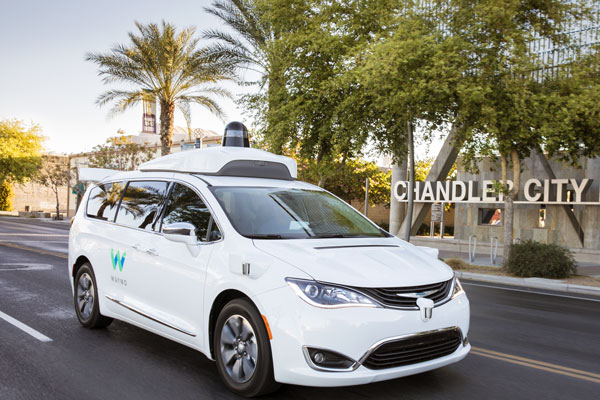
From a driver to a passenger: building confidence in the switch to self-driving cars
While there is a growing generation of people who have never learnt to drive – and are increasingly planning never to do so in anticipation of the rollout of self-driving cars – for most the technology represents a huge shift in the way they control their journeys.
“For the last hundred years, vehicles have largely stayed the same. You open the front door, get into the driver's seat, start the car, step onto the accelerator and go,” says Krafcik. “But the way we use fully self-driving cars, we think, will be fundamentally different. Our role will shift from a driver to that of a full-time passenger who isn't responsible for any part of driving.”
This is likely to be the biggest challenge Waymo has left to overcome. Some, of course, will be happy to give up the wheel, but others will likely be deeply distrustful of the experience. And it is these people Waymo has had in mind in its development of the user experience.
“We have to create new customs and norms for how passengers interact with cars that drive themselves,” he says. “Now when you're a passenger in a car driven by a human, there's a lot of communication that happens between you and the driver. Some of its verbal, some of its non-verbal. In a fully self-driving car, we've got to find a way to build trust between riders and our technology.”
“We didn’t say, ‘let’s build a chatbot because it’s cool’. Instead, it was ‘let’s actually figure out our AI and how these new technologies really help the experience’”
This has involved the development of alternative ways to inform passengers of what’s going on around them, in a way that builds confidence and doesn’t leave them feeling nervous about the situation.
“One way we're doing this is through our in-car screens. Here we've thought through the details, like what type of information to show, and how to show it,” he says. “The goal is to share what the vehicle is seeing and thinking without overloading riders with too much information, and it begins with curating all the types of information and objects we display, as well as how and when to highlight them.”
As part of this, Waymo uses subtle cues reminiscent of those used in conventional software design to indicate the sophistication of its technology. For example, the in-car screen highlights pedestrians and cyclists to show it has spotted them, but does so in different colours to show it recognises the difference between them.
Such touches are minor and are unlikely to be recognised consciously by many passengers, but they help to build an unconscious trust in the vehicle.
“This kind of communication is crucial, because when people feel confident and comfortable in a fully self-driving vehicle, more and more of us will want to use them in our daily lives,” says Krafcik.
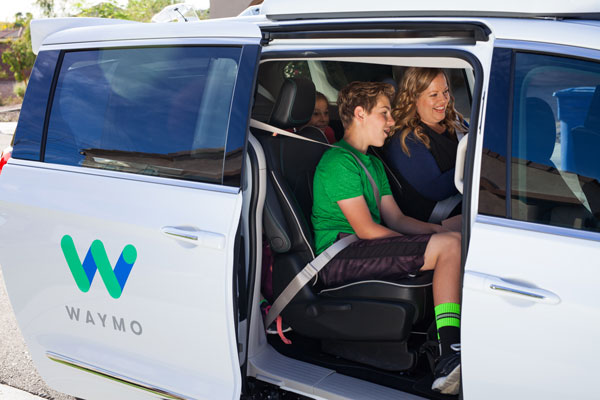
On to a world of self-driving cars
In addition to making users feel confident about the technology, Waymo is also keen to get them to buy into the vision of a safer, healthier and more environmentally friendly world, as created by self-driving cars.
“The reality is, everyone, everywhere, stands to benefit from self-driving technology,” says Krafcik. “More than that, when you consider the state of driving today, it’s also clear that our roads need to be safer. It's sort of crazy: 1.2 million people die annually on our roadways.
“That's the equivalent of a 737 falling out of the sky every hour of every day. And as many as 50 million people are injured in crashes every year, many incurring permanent disabilities as a result.”
Then there’s the notion of a single car for each person, which Krafcik paints as undesirable and ill-suited to our lives.
“Think about this for a minute: today, personal cars are often the second-largest purchase we make in our lives, after a home, and once we buy a vehicle, that's the one we have to use everyday, day in and day out,” he says.
“That means people may buy a large SUV for the one day a year they hope to take the car off-road, but the other 354 days they're the sole occupant in a big eight-seat vehicle, travelling an hour to work each way, wasting fuel, space and creating CO2 and pollution.
“Not only is that car not suited to most of its usage, it’s also sitting idle, on average, 95% of the time. Think of that waste; that's like pouring out five litres of water for every glass that you drink.”
“A small fleet of fully self-driving cars could serve an entire community. There are other benefits too: parking lots could be formed into parks; fewer traffic crashes could ease congestion”
In addition, he argues, almost two-thirds of trips in the US are less than 2km long. In essence, the way we currently own and operate vehicles – in a manner that is ubiquitous across the world – is wasteful and inappropriate to our needs.
“With each car being driven so little and for what are mostly short trips, Waymo's technology allows vehicles to be used in a different way,” he says.
“A small fleet of fully self-driving cars could serve an entire community. There are other benefits too: parking lots could be formed into parks; fewer traffic crashes could ease congestion. This technology could unlock the full potential of shared mobility.”
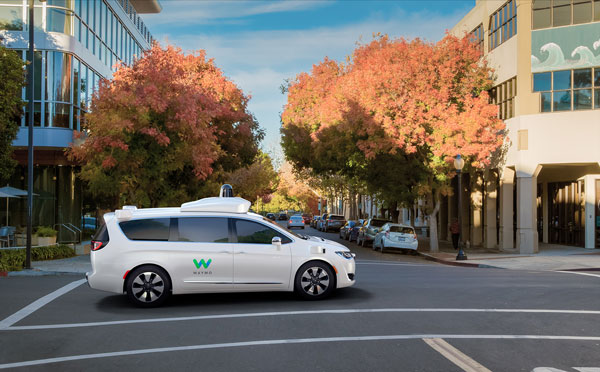
On to a world of self-driving cars
Now Waymo has developed a market-ready version of its technology, its focus is turning to how it can begin to profit on the last eight years of work. And it is this vision of shared mobility that it is hoping will allow it to recoup the vast investment it has ploughed into developing its technology.
“Because we see so much potential in shared mobility, the first way we're going to experience fully self-driving technology will be in Waymo Driverless Service,” explains Krafcik. “We're now working on making this commercial service available to the public. People get to use our fleet of on-demand vehicles to do anything from commute to work, get home from a night out, run errands, whatever they like.”
While the company hasn’t given a precise start date for this service, its clear that it is putting all its efforts into making it a reality, with the first offering set to start in limited parts of the US later this year and a thousands-strong fleet of vehicles already on order from Fiat Chrysler.
“Getting access will be as easy as using an app: you just tap a button and Waymo will come to get you and take you where you want to go. The vehicles will be fully self-driving, so you have your own personal space where you can sit back and relax,” he says.
“And it makes sense that we would start by giving people access to our fleet. This'll make Waymo available to more people in a more cost-effective way, and for us, having more people experience fully self-driving vehicles early is valuable; it will let us learn about how people want to use this technology, and those insights will inform our future work.”
“Because you're accessing vehicles rather than owning them, in the future you could have access to an entire fleet of vehicle choices, each one tailored to the trip you want to take”
In the long run, Waymo envisions its vehicles being used for everything from business trips and commutes to sightseeing trips and holidays, with users able to select the most appropriate vehicle for each activity.
“In the long term, Waymo could take you on all kinds of trips. Because you're accessing vehicles rather than owning them, in the future you could have access to an entire fleet of vehicle choices, each one tailored to the trip you want to take,” says Krafcik.
“You could re-imagine the very idea of what a vehicle is, because they no longer have to be designed around the driver as the primary user. They can instead be designed for specific purposes and tasks that better suit our needs as riders or as users.
“There might be a design that's great for napping, there might be one that's perfect as a personal dining room, one as a mobile office, or even one just for those times you're moving into a new place. You could even have that SUV for your weekend trips if you like, and you can take these vehicles for one ride, for a day, for a week or even longer.”
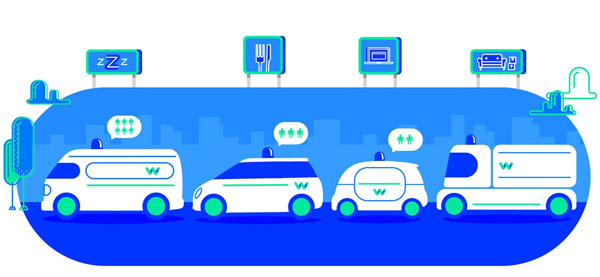
Images courtesy of Waymo
